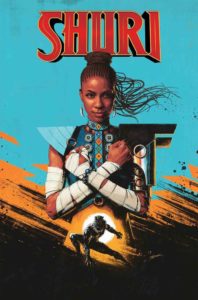 Shuri #1 (of 6?) — Writer: Nnedi Okorafor; Art: Leonardo Romero; Colors: Jordie Bellaire
Shuri #1 (of 6?) — Writer: Nnedi Okorafor; Art: Leonardo Romero; Colors: Jordie Bellaire
The Unstoppable Wasp #1 — Writer: Jeremy Whitley; Art/Colors: Gurihiru
X-Men Black — Mystique #1 (of 1) — Writer: Seanan McGuire; Art: Marco Failla; Colors: Jesus Aburtov
Shuri is a solo mini-series about the Black Panther’s techno-genius younger sister; Okorafor, the writer, an American-born daughter to two Nigerian immigrants, has  a better background to write realistic, strong African women than most, and Leonardo Romero’s art, in the school of Chris Samnee and David Aja, is attractive and open and meticulous, with every line in place. Add in the reader-friendly connections to the main Panther book and the photo-realistic Sam Spratt cover, and this is off to a good start. Unstoppable Wasp #1 is really just a continuation of the previous series (as the “Legacy #009” on the cover slyly acknowledges), with the same writer, the same main character and supporting cast, and
a better background to write realistic, strong African women than most, and Leonardo Romero’s art, in the school of Chris Samnee and David Aja, is attractive and open and meticulous, with every line in place. Add in the reader-friendly connections to the main Panther book and the photo-realistic Sam Spratt cover, and this is off to a good start. Unstoppable Wasp #1 is really just a continuation of the previous series (as the “Legacy #009” on the cover slyly acknowledges), with the same writer, the same main character and supporting cast, and  the same emphasis on girls in STEM-related careers. It does have new artists, the Japanese team Gurihiru, but since they’re fresh from the recently-cancelled Gwenpool, which was aimed at a very similar Scholastic Book Club-ish audience, they fit right in; you don’t have to be a girl to like this, but if you are (or are buying comics for someone who is), you probably will. X-Men Black continues its one-shot spotlights on villains with Mystique; she might be one of the best-known ones, thanks to the movies, and this story highlights her powers well, although with only 20 pages to work with she comes off as too simply malevolent, with no time for shadings or sympathy-building.
the same emphasis on girls in STEM-related careers. It does have new artists, the Japanese team Gurihiru, but since they’re fresh from the recently-cancelled Gwenpool, which was aimed at a very similar Scholastic Book Club-ish audience, they fit right in; you don’t have to be a girl to like this, but if you are (or are buying comics for someone who is), you probably will. X-Men Black continues its one-shot spotlights on villains with Mystique; she might be one of the best-known ones, thanks to the movies, and this story highlights her powers well, although with only 20 pages to work with she comes off as too simply malevolent, with no time for shadings or sympathy-building.
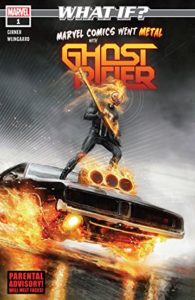 What If? Ghost Rider #1 (of 1) — Writer: Sebastian Girner; Art/Colors: Caspar Wijngaard
What If? Ghost Rider #1 (of 1) — Writer: Sebastian Girner; Art/Colors: Caspar Wijngaard
True Believers: What If The Alien Costume Had Possessed Spider-Man? #1 (of 1) — Writer: Danny Fingeroth; Pencils: Mark Bagley; Inks: Keith Williams; Colors: Tom Vincent
True Believers: What If the Fantastic Four Had Not Gained Their Powers? #1 (of 1) — Writer/Artist: John Byrne; Colors: Bob Sharon
 This week’s What If? Ghost Rider doesn’t use the classic change-one-event setup (like the two “True Believer” reprints do); instead, it’s more a “What if Robbie Reyes was an intern at Marvel Comics, and a Latverian heavy-metal band they were doing a comic about came in and put their blood into the printer ink, but it was demonic and infected everyone who read the comic, and so he had to turn into Ghost Rider to deal with it?” This comic’s tongue is stuck so far in its cheek that it’s
This week’s What If? Ghost Rider doesn’t use the classic change-one-event setup (like the two “True Believer” reprints do); instead, it’s more a “What if Robbie Reyes was an intern at Marvel Comics, and a Latverian heavy-metal band they were doing a comic about came in and put their blood into the printer ink, but it was demonic and infected everyone who read the comic, and so he had to turn into Ghost Rider to deal with it?” This comic’s tongue is stuck so far in its cheek that it’s 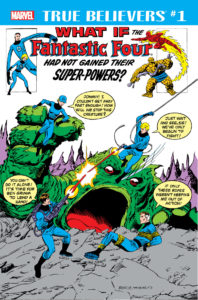 coming out of its nose, but if you can get past that, and do or used to do some head-banging yourself, you might appreciate its fight-the-man attitude and open-ended, occult-apocalyptic conclusion. Of the reprints, What If The Alien Costume Had Possessed Spider-Man? is the most timely (and the more expensive for the original issue, thanks to the Venom movie), while What If the Fantastic Four Had Not Gained Their Powers? is the better comic, thanks to its being a John Byrne writer/artist production back when he was still doing the regular FF book, and at the height of his powers; however, at $1 each they’re both worth picking up.
coming out of its nose, but if you can get past that, and do or used to do some head-banging yourself, you might appreciate its fight-the-man attitude and open-ended, occult-apocalyptic conclusion. Of the reprints, What If The Alien Costume Had Possessed Spider-Man? is the most timely (and the more expensive for the original issue, thanks to the Venom movie), while What If the Fantastic Four Had Not Gained Their Powers? is the better comic, thanks to its being a John Byrne writer/artist production back when he was still doing the regular FF book, and at the height of his powers; however, at $1 each they’re both worth picking up.
 Venom Annual #1 — Creators: Various
Venom Annual #1 — Creators: Various
Thor #6 (Legacy #712) — Writer: Jason Aaron; Art/Colors: Christian Ward
Peter Parker, the Spectacular Spider-Man #311 — Writer: Sean Ryan; Art: Juan Frigeri; Colors: Jason Keith
Mr. and Mrs. X #4 — Writer: Kelly Thompson; Art: Oscar Bazuldua; Colors: Frank D’Armata
 Runaways #14 — Writer: Rainbow Rowell; Art: David Lafuente and Takeshi Miyazawa; Colors: Jim Campbell and Michael Garland
Runaways #14 — Writer: Rainbow Rowell; Art: David Lafuente and Takeshi Miyazawa; Colors: Jim Campbell and Michael Garland
Daredevil #609 — Writer: Charles Soule; Art: Phil Noto
Venom‘s been hot lately, so an annual’s a natural response; this one has the regulars at a super-villain bar each telling about their encounters with the symbiote; current Venom writer Donny Cates does the framing sequences with Kev 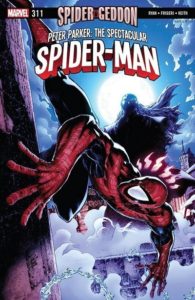 Walker, while individual stories are by: Venom’s co-creator David Michelenie, with Ron Lim and Scott Hanna; Jeff Loveless and Tigh Walker; and writer/artist James Stokoe. That’s a wide-ranging group of creators, but the anthology format blends them effectively; there should be a story in here somewhere to satisfy any reader’s taste. Thor continues its break from the long-running “War of the Ten Realms” story to tell a tale about the far-future Thor and his offspring, fighting the few powerful forces left in a heat-death-wracked universe;
Walker, while individual stories are by: Venom’s co-creator David Michelenie, with Ron Lim and Scott Hanna; Jeff Loveless and Tigh Walker; and writer/artist James Stokoe. That’s a wide-ranging group of creators, but the anthology format blends them effectively; there should be a story in here somewhere to satisfy any reader’s taste. Thor continues its break from the long-running “War of the Ten Realms” story to tell a tale about the far-future Thor and his offspring, fighting the few powerful forces left in a heat-death-wracked universe; 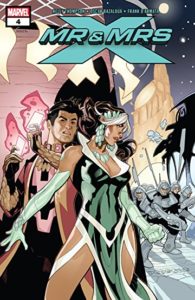 if you liked Donny Cates’s far-future Thanos story, with its Cosmic Ghost Rider/Punisher combo, then you should like the Wolverine/Phoenix one, and the Doctor Doom/four other characters compilation featured here, and Christian Ward’s ethereal, color-drenched art gives it just the right dreamlike, end-of-time atmosphere. Peter Parker, the Spectacular Spider-Man begins a three-part tie-in to the Spider-Geddon mini-series, with Pete in a one-on-one fight against the formidable Morlun, the J. Michael Straczynski-created energy vampire and spider-killer. Mr. and Mrs. X
if you liked Donny Cates’s far-future Thanos story, with its Cosmic Ghost Rider/Punisher combo, then you should like the Wolverine/Phoenix one, and the Doctor Doom/four other characters compilation featured here, and Christian Ward’s ethereal, color-drenched art gives it just the right dreamlike, end-of-time atmosphere. Peter Parker, the Spectacular Spider-Man begins a three-part tie-in to the Spider-Geddon mini-series, with Pete in a one-on-one fight against the formidable Morlun, the J. Michael Straczynski-created energy vampire and spider-killer. Mr. and Mrs. X 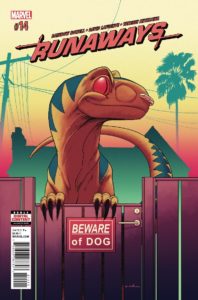 continues Kelly Thompson and Oscar Bazaldua’s tone-perfect romcom/superhero/X-book, with Rogue and Gambit in space, teamed up with the Starjammers against the Imperial Guard and other forces trying to capture Xandra, the daughter of Professor X and the alien Shi’ar queen Lilandra, whom everyone but our heroes sees as an egg; that sounds complicated, but is presented smoothly and entertainingly enough to work. Runaways is another tone-perfect comic; it reminds me of Kieron Gillon and Jamie McKelvie’s Young Avengers in the way it combines ping-ponging young-adult relationships among its now-six
continues Kelly Thompson and Oscar Bazaldua’s tone-perfect romcom/superhero/X-book, with Rogue and Gambit in space, teamed up with the Starjammers against the Imperial Guard and other forces trying to capture Xandra, the daughter of Professor X and the alien Shi’ar queen Lilandra, whom everyone but our heroes sees as an egg; that sounds complicated, but is presented smoothly and entertainingly enough to work. Runaways is another tone-perfect comic; it reminds me of Kieron Gillon and Jamie McKelvie’s Young Avengers in the way it combines ping-ponging young-adult relationships among its now-six  original cast members (seven, counting Gertie the dinosaur, who gets a striking cover by Kris Anka you can see directly above this) with super-powers and cosmic menaces. Daredevil, one of the few Marvel titles that hasn’t done a relaunch and renumbering lately, is gearing up for just that with a new “Death of Daredevil” serial; since they just introduced an accidentally-Inhuman-created “Mike” Murdoch, a near-duplicate of Matt, a few issues ago, there are a couple of obvious paths they might take. Charles Soule, the writer, has shown a knack for clever, longer-form planning in books like She-Hulk, so let’s hope it all hangs together and isn’t too obvious or eye-rolling; the painterly Phil Noto art helps quite a bit, too.
original cast members (seven, counting Gertie the dinosaur, who gets a striking cover by Kris Anka you can see directly above this) with super-powers and cosmic menaces. Daredevil, one of the few Marvel titles that hasn’t done a relaunch and renumbering lately, is gearing up for just that with a new “Death of Daredevil” serial; since they just introduced an accidentally-Inhuman-created “Mike” Murdoch, a near-duplicate of Matt, a few issues ago, there are a couple of obvious paths they might take. Charles Soule, the writer, has shown a knack for clever, longer-form planning in books like She-Hulk, so let’s hope it all hangs together and isn’t too obvious or eye-rolling; the painterly Phil Noto art helps quite a bit, too.
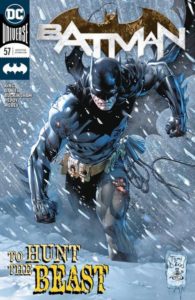 Batman #57 — Writer: Tom King; Art: Tony S. Daniel, Mark Buckingham and Andrew Pepoy; Colors: Tomeu Morey
Batman #57 — Writer: Tom King; Art: Tony S. Daniel, Mark Buckingham and Andrew Pepoy; Colors: Tomeu Morey
Nightwing #51 — Writers: Scott Lobdell with Fabian Nicieza; Art: Travis Moore and Garry Brown; Colors: Hi-Fi and Nick Filardi
Justice League Dark #4 — Writer: James Tynion IV; Pencils: Alvaro Martinez Bueno; Inks: Raul Fernandez; Colors: Brad Anderson
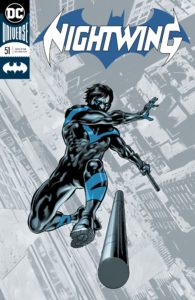 Justice League #10 — Writer: Scott Snyder; Art/Colors: Francis Manapul
Justice League #10 — Writer: Scott Snyder; Art/Colors: Francis Manapul
Lucifer #1 — Writer: Dan Watters; Art: Max Fiumara and Sebastian Fiumara; Colors: Dave McCaig
Pearl #3 — Writer: Brian Michael Bendis; Art/Colors: Michael Gaydos
Cover #2 — Writer: Brian Michael Bendis; Art: David Mack; Colors: Zu Orzu
 The Bat-comics are still dealing with the consequences of former Robin Dick Grayson getting shot in the head, and losing most memories of his last 15 years; Batman involves tracking down the sniper (the guy who used to be called the KGBeast, and is apparently now just “Beast,” the KGB no longer being a thing unless you’re a nostalgic Vladimir Putin…), and is a long Tony Daniels-drawn fight scene, punctuated mostly by grunts and growls. Bonus: it’s interspersed with pages of a Russian animal fable, drawn by Mark Buckingham and Andrew Pepoy; extra points to Tom King for being a Fables fan, and giving them a chance
The Bat-comics are still dealing with the consequences of former Robin Dick Grayson getting shot in the head, and losing most memories of his last 15 years; Batman involves tracking down the sniper (the guy who used to be called the KGBeast, and is apparently now just “Beast,” the KGB no longer being a thing unless you’re a nostalgic Vladimir Putin…), and is a long Tony Daniels-drawn fight scene, punctuated mostly by grunts and growls. Bonus: it’s interspersed with pages of a Russian animal fable, drawn by Mark Buckingham and Andrew Pepoy; extra points to Tom King for being a Fables fan, and giving them a chance  to work in that style again. Meanwhile, over in Nightwing, Dick (now calling himself “Ric”), is driving a cab in Bludhaven, trying to figure out why people like Alfred are worried about him, and puzzled at his instinctive ability to beat the crap out of anyone who messes with him; this may all seem manipulative of DC, but it’s worked: I’m now interested in the comic for the first time in many, many years. Justice League Dark offers the third chapter of The Witching Hour, a crossover with Wonder Woman that involves that character coping with dark magical
to work in that style again. Meanwhile, over in Nightwing, Dick (now calling himself “Ric”), is driving a cab in Bludhaven, trying to figure out why people like Alfred are worried about him, and puzzled at his instinctive ability to beat the crap out of anyone who messes with him; this may all seem manipulative of DC, but it’s worked: I’m now interested in the comic for the first time in many, many years. Justice League Dark offers the third chapter of The Witching Hour, a crossover with Wonder Woman that involves that character coping with dark magical  powers that are tied into a world-threatening apocalypse by the witch-goddess Hecate; this is one of an increasing number of weekly-installment stories, whose every-seven-day schedule keeps readers from losing interest and wandering off, and as with Nightwing, while it might be a marketing ploy, it’s a successful one. Over in the main Justice League title, there’s the prelude to yet another such series, an Aquaman-centered one called The Drowned Earth, wherein space aliens/gods arrive to turn the planet into all ocean; it works well because Scott Snyder and Francis
powers that are tied into a world-threatening apocalypse by the witch-goddess Hecate; this is one of an increasing number of weekly-installment stories, whose every-seven-day schedule keeps readers from losing interest and wandering off, and as with Nightwing, while it might be a marketing ploy, it’s a successful one. Over in the main Justice League title, there’s the prelude to yet another such series, an Aquaman-centered one called The Drowned Earth, wherein space aliens/gods arrive to turn the planet into all ocean; it works well because Scott Snyder and Francis 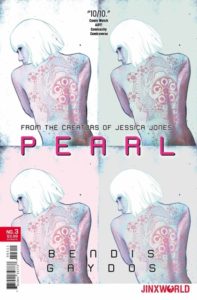 Manapul are good at their respective storytelling jobs. The good news is that it’s only involving the Aquaman and JL titles, plus two stand-along bookends, and should be done by the end of November. Lucifer is another Sandman-universe Vertigo launch, using the longstanding Neil Gaiman version of the Biblical archangel and temptor; it opens well by going against type, with the normally-debonair and in-control title character bearded, trapped and confused, and, provided it isn’t stretched out too long, watching him pull himself together and annihilate his enemies should be entertaining enough. That leaves two Brian Michael Bendis titles from his DC Jinxworld imprint; Pearl is about a girl who’s both a tattoo artist and
Manapul are good at their respective storytelling jobs. The good news is that it’s only involving the Aquaman and JL titles, plus two stand-along bookends, and should be done by the end of November. Lucifer is another Sandman-universe Vertigo launch, using the longstanding Neil Gaiman version of the Biblical archangel and temptor; it opens well by going against type, with the normally-debonair and in-control title character bearded, trapped and confused, and, provided it isn’t stretched out too long, watching him pull himself together and annihilate his enemies should be entertaining enough. That leaves two Brian Michael Bendis titles from his DC Jinxworld imprint; Pearl is about a girl who’s both a tattoo artist and 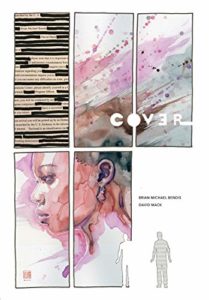 a reluctant, if very skilled, assassin for the Yakuza, and is good because Bendis is masterful at crime/suspense/noir stuff, especially when crossed with a Romeo-and-Juliet metaplot, and because Michael Gaydos is a stylish artist who draws beautiful pictures. Similarly, Cover has the high-concept hook that comic artists are being recruited by the government to work as spies (they travel out of country to conventions all the time, you see…), and also benefits from Bendis’s crime chops (most of the book is an interrogation scene) and because of David Mack, yet another careful, detailed artist who draws very pretty pictures; one of the best indications of Bendis’s writing skills is all the great artists who line up to collaborate with him.
a reluctant, if very skilled, assassin for the Yakuza, and is good because Bendis is masterful at crime/suspense/noir stuff, especially when crossed with a Romeo-and-Juliet metaplot, and because Michael Gaydos is a stylish artist who draws beautiful pictures. Similarly, Cover has the high-concept hook that comic artists are being recruited by the government to work as spies (they travel out of country to conventions all the time, you see…), and also benefits from Bendis’s crime chops (most of the book is an interrogation scene) and because of David Mack, yet another careful, detailed artist who draws very pretty pictures; one of the best indications of Bendis’s writing skills is all the great artists who line up to collaborate with him.
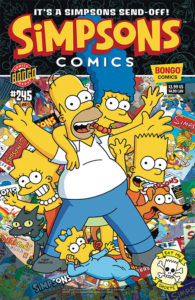 Simpsons Comics #245 — Writer: Nathan Kane; Pencils: Rex Lindsey; Inks: Andrew Pepoy; Colors: Art Villanueva
Simpsons Comics #245 — Writer: Nathan Kane; Pencils: Rex Lindsey; Inks: Andrew Pepoy; Colors: Art Villanueva
Exorsisters #1 — Writer: Ian Boothby; Art: Gisele Lagace; Colors: Pete Pantazis
Archie 1941 #2 (of 5) — Writers: Brian Augustyn and Mark Waid; Art: Peter Krause; Colors: Kelly Fitzpatrick
Cemetery Beach #2 (of 7) — Writer: Warren Ellis; Art/Colors: Jason Howard
Black Badge #3 — Writer: Matt Kindt; Art: Tyler Jenkins; 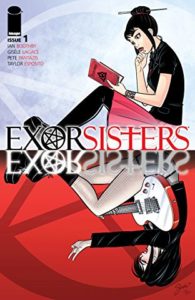 Colors: Hillary Jenkins
Colors: Hillary Jenkins
The Simpsons comic is worth noting because it’s the final issue, after over 20 years (Bongo says at the end it’s going on “hiatus,” and advertises an all-new Simpsons special book “soon,” although it’s hard to tell what the odds are of any other books being published); get this because a 20-year-plus run is impressive for any comic, and because the quality of the stories has always been high, both faithful to the show’s tone and dependably entertaining. By my count, that leaves Adventure Time (although the show itself is ending), Duck Tales and Rick and Morty as the only ongoing TV-cartoon tie-ins left. Speaking of The Simpsons, Ian Boothby, one of their top writers, has just released 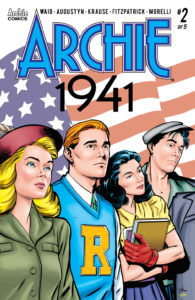 Exorsisters, a new ongoing Image book about two sisters (well, it turns out their relationship is more complicated than that, but let’s go with “sisters” for now…), who run an occult investigation agency. Points for starting with a done-in-one story that does a good job of delineating the two girls’ characters and telling a satisfying mystery; Gisele Lagace has a kind-of manga-y/Archie style that fits the combination of humor and potential danger well, and the twist at the end should bring readers back for issue #2. Archie itself has its flagship title on hiatus, in favor of the five-issue Archie: 1941, which imagines the Riverdale gang if they’d been graduating high school in 1941, the year they
Exorsisters, a new ongoing Image book about two sisters (well, it turns out their relationship is more complicated than that, but let’s go with “sisters” for now…), who run an occult investigation agency. Points for starting with a done-in-one story that does a good job of delineating the two girls’ characters and telling a satisfying mystery; Gisele Lagace has a kind-of manga-y/Archie style that fits the combination of humor and potential danger well, and the twist at the end should bring readers back for issue #2. Archie itself has its flagship title on hiatus, in favor of the five-issue Archie: 1941, which imagines the Riverdale gang if they’d been graduating high school in 1941, the year they  first appeared (in Pep Comics #22)… just before Pearl Harbor and the US entry into WWII. The war keeps this serious, not cartoony; the characters are still familiar, but they’re dealing with life-and-death events — and the fact that no one can escape their effects is exactly the point. Cemetery Beach is the latest Warren Ellis book, with his Trees collaborator Jason Howard; it’s about a space colony founded by Earth explorers in the early 1900s, who made it on the primitive, Jules Verne-like tech of the times and then were forgotten — but now, Earth has sent a scout to find them; he’s run into a hostile reception and hooked up with an imprisoned dissident woman, and they’re being pursued by
first appeared (in Pep Comics #22)… just before Pearl Harbor and the US entry into WWII. The war keeps this serious, not cartoony; the characters are still familiar, but they’re dealing with life-and-death events — and the fact that no one can escape their effects is exactly the point. Cemetery Beach is the latest Warren Ellis book, with his Trees collaborator Jason Howard; it’s about a space colony founded by Earth explorers in the early 1900s, who made it on the primitive, Jules Verne-like tech of the times and then were forgotten — but now, Earth has sent a scout to find them; he’s run into a hostile reception and hooked up with an imprisoned dissident woman, and they’re being pursued by  the authorities. Lots of action, mixed with typically-arch dialogue between the two principles as they banter and dodge bullets, makes this a fun and easy-to-like read. Black Badge, about Boy Scouts who have graduated to an elite troop that’s actually doing black-ops work for the US government (they need to cross over with the similarly-employed comic artists in Cover…), has its kids looking for a vanished partner in Pakistan, and getting tangled in the typical double- and triple-crosses; writer Matt Kindt is good at this sort of cynical international intrigue (see his Mind MGMT), and the Scouting hook is still intriguing enough, three issues in, to carry the story.
the authorities. Lots of action, mixed with typically-arch dialogue between the two principles as they banter and dodge bullets, makes this a fun and easy-to-like read. Black Badge, about Boy Scouts who have graduated to an elite troop that’s actually doing black-ops work for the US government (they need to cross over with the similarly-employed comic artists in Cover…), has its kids looking for a vanished partner in Pakistan, and getting tangled in the typical double- and triple-crosses; writer Matt Kindt is good at this sort of cynical international intrigue (see his Mind MGMT), and the Scouting hook is still intriguing enough, three issues in, to carry the story.
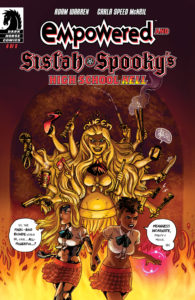 Empowered #6 (of 6) — Writer Adam Warren; Art: Carla Speed McNeil; Colors: Jenn Manley Lee
Empowered #6 (of 6) — Writer Adam Warren; Art: Carla Speed McNeil; Colors: Jenn Manley Lee
Stray Bullets: Sunshine and Roses #39 — Creator: David Lapham
Lumberjanes #55 — Writers: Shannon Watters and Kat Leyh; Art: Dozerdraws; Colors: Maarta Laiho
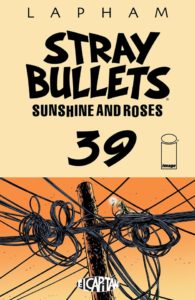 Strangers in Paradise XXV #7 (of 12) — Creator: Terry Moore
Strangers in Paradise XXV #7 (of 12) — Creator: Terry Moore
We’re concluding with the section of comics I’ve been recommending for years, so it seems redundant to say much more about them (although you can look up previous reviews in the archives); Empowered finishes its latest mini-series, about being trapped in a hell that looks just like your old high school, with creator Adam 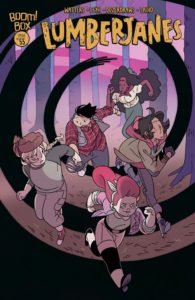 Warren’s typically-inspiring and clever script, and guest artist Carla Speed McNeil’s wonderful art, which handles the emotions and the action with equal elan. Stray Bullets is typically-noir shenanigans from David Lapham, rounding into a conclusion after over three years of a single story, with one big revelation in this issue that’s done so casually that I missed it the first time — and, as a bonus, the final face-off is taking place in Phoenix; they even mention
Warren’s typically-inspiring and clever script, and guest artist Carla Speed McNeil’s wonderful art, which handles the emotions and the action with equal elan. Stray Bullets is typically-noir shenanigans from David Lapham, rounding into a conclusion after over three years of a single story, with one big revelation in this issue that’s done so casually that I missed it the first time — and, as a bonus, the final face-off is taking place in Phoenix; they even mention 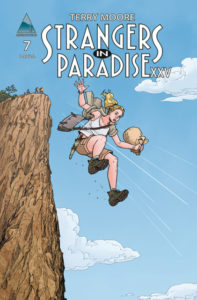 West Van Buren Street. Lumberjanes is about girl scouts at a summer camp in what’s turned out to be a magical forest; that sounds like a recipe for Disneyized cuteness, but it’s actually more adventurous and smart than that, more Duck Tales than Bambi. Strangers in Paradise XXV is Terry Moore chronicling new adventures of old friends, over halfway through the story and cranking up the suspense and menace, both for Katchoo and for her family back home; the “XXV” in the title reminds us that Moore has been writing about these people for 25 years now, with this latest installment a dessert to a fondly-remembered cult classic.
West Van Buren Street. Lumberjanes is about girl scouts at a summer camp in what’s turned out to be a magical forest; that sounds like a recipe for Disneyized cuteness, but it’s actually more adventurous and smart than that, more Duck Tales than Bambi. Strangers in Paradise XXV is Terry Moore chronicling new adventures of old friends, over halfway through the story and cranking up the suspense and menace, both for Katchoo and for her family back home; the “XXV” in the title reminds us that Moore has been writing about these people for 25 years now, with this latest installment a dessert to a fondly-remembered cult classic.



